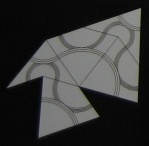The Grand Vizier: A Penrose tiling puzzle

For the 2002 puzzle party in Antwerp, I wanted to design something that would lead people to explore the strange world of Penrose's non-periodic kite-and-dart tiles. Some years earlier, someone else had already exchanged a Penrose-based puzzle; that one was just a set of kites and darts that had been distorted a bit to resemble two kinds of birds (and to enforce the normal edge-matching rules). The goal had been simply to fit them together to make the classic regular decagon that crops up every you look in any tiling.
For my own puzzle, I wanted to challenge you to do more than simply learn how to tile the pieces; I wanted it to be a real puzzle. I played around with a Penrose tiling applet for a while and came up with an outline that looked, to me anyway, a lot like the head of a man wearing a turban. That shape required 76 tiles to make, so I broke it up into a set of 16 multi-tile pieces, each containing between 3 and 5 tiles. I then laser cut and etched those pieces with Conway's beautiful curves that show where the legal edge matches are. The resulting puzzle has a unique solution and is fairly difficult.
To make it a bit easier, I added a little removable panel that reveals where some of the tile boundaries are (and that shows why I thought the shape looked like a Grand Vizier). I also included in the package a "little bit bigger hint" that shows where all of the tile boundaries are (but not the piece boundaries, of course).
Finally, I discovered that a subset of pieces I'd chosen could be assembled to form that same classic decagon I mentioned above, so I made the puzzle tray two sided, with the outline of the Grand Vizier on the front and the outline of the decagon on the back. Oddly enough, even though I don't tell you which subset of the pieces you have to use in filling the decagon tray, that side is definitely easier than the front.